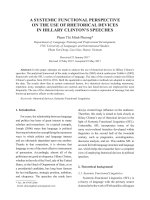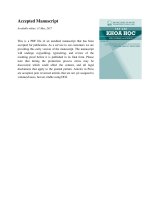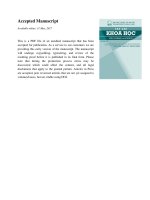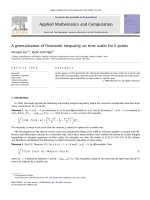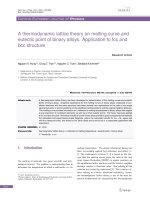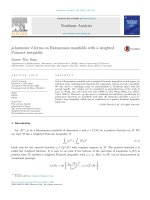DSpace at VNU: A thermodynamic lattice theory on melting curve and eutectic point of binary alloys. Application to fcc and bcc structure
Bạn đang xem bản rút gọn của tài liệu. Xem và tải ngay bản đầy đủ của tài liệu tại đây (655.71 KB, 8 trang )
Cent. Eur. J. Phys. • 9(1) • 2011 • 222-229
DOI: 10.2478/s11534-010-0065-1
Central European Journal of Physics
A thermodynamic lattice theory on melting curve and
eutectic point of binary alloys. Application to fcc and
bcc structure
Research Article
Nguyen V. Hung1∗ , Dung T. Tran1† , Nguyen C. Toan1 , Barbara Kirchnner2
1 Department of Physics, University of Science, VNU-Hanoi,
334 Nguyen Trai, Thanh Xuan, Hanoi, Vietnam
2 Wilhelm-Ostwald-Institute for Physical and Theoretical Chemistry, University of Leipzig,
Linnéstr. 2, 04103 Leipzig, Germany
Received 10 February 2010; accepted 1 July 2010
Abstract:
A thermodynamic lattice theory has been developed for determination of the melting curves and eutectic
points of binary alloys. Analytical expressions for the melting curves of binary alloys composed of constituent elements with the same structure have been derived from expressions for the ratio of root mean
square fluctuation in atomic positions on the equilibrium lattice positions and the nearest neighbor distance.
This melting curve provides information on Lindemann’s melting temperatures of binary alloys with respect
to any proportion of constituent elements, as well as on their eutectic points. The theory has been applied
to fcc and bcc structure. Numerical results for some binary alloys provide a good correspondence between
the calculated and experimental phase diagrams, where the calculated results for Cu1−x Nix agree well
with the measured ones, and those for the other alloys are found to be in a reasonable agreement with
experiment.
PACS (2008): 61.10.Ht
Keywords:
thermodynamic lattice theory • Lindemann’s melting temperature • eutectic point • binary alloys
© Versita Sp. z o.o.
1.
Introduction
The melting of materials has great scientific and technological interest. The problem is understanding how to
determine the temperature at which a solid melts, i.e., its
∗
E-mail:
Present address: Dept. of Metallurgy and Materials, University of Birmingham, Edgbaston, Birmingham, UK. B15 2TT.
†
222
melting temperature. The atomic vibrational theory has
been successfully applied by Lindemann and others [1–
4]. The Lindemann’s criterion [1, 2] is based on the concept that the melting occurs when the ratio of the root
mean square fluctuation (RMSF) in atomic positions on
the equilibrium lattice positions and the nearest neighbor
distance reaches a threshold value. The validity of this
criterion was tested by experiment [5]. This criterion relates melting to a lattice vibrational instability. Hence,
the thermodynamic lattice theory is one of the most important fundamentals for interpreting the thermodynamic
Nguyen V. Hung, Dung T. Tran, Nguyen C. Toan, Barbara Kirchnner
properties and melting of materials [1–6, 9, 18–23]. Binary alloys having liquidus consisting of two branches in
their phase diagram or melting curve are called eutectics
[6] and the minimum solidification temperature is called
the eutectic temperature [6]. The binary alloy phase diagrams have been experimentally studied [7]. Phenomenological theory of the phase diagrams of the binary eutectic
systems [8] has been developed to show qualitatively the
temperature-concentration diagrams of eutectic mixtures
using a Landau-type approach, which involves a coupling
between the liquid-solid transition order-parameters and
a specific nonlinear dependence on concentration of the
free-energy coefficients. Here the eutectic point is considered more generally as the minimum of the melting
curve. X-ray absorption fine structure (XAFS) [9] in studying melting is focused mainly on the Fourier transform
magnitudes and cumulants of XAFS. The melting curve
of materials from theory versus experiments [10] has been
studied based on quantum mechanics within the framework
of density functional theory, with use of the generalized
gradient corrections, but this is focused mainly on the dependence of the melting temperature of single elements
on pressure. Empirical rules [1, 11–13] have been used to
characterize the melting transition of solids as useful procedures in computer simulations without performing free
energy calculations [14]. The mechanism for the solidliquid phase transition based on the Lindemann’s criterion
has been studied using Monte-Carlo simulation [15], but
a complete “ab initio” theory for the melting transition is
not available [11, 15]. As such, the calculation of melting
temperature curves versus proportions of constituent elements of binary alloys and their eutectic points still can
be a useful contribution to the field.
The purpose of this work is to derive a thermodynamic
lattice theory for analytical calculation and analysis of
the melting curves or phase diagrams and eutectic points
of binary alloys composed of any constituent elements
with the same structure. Our development in Sec. 2 is
a derivation of the analytical expressions for the atomic
mean square displacement (MSD), mean lattice energy,
atomic mean square fluctuation (MSF), and then the ratio
of the RMSF in atomic positions on the equilibrium lattice positions and the nearest neighbor distance, as well
as the melting curves of binary alloys. This melting curve
contains the atomic proportion of constituent elements and
their melting temperatures in the limiting cases when the
whole elementary cell is occupied by the atoms of one of
the constituent elements. Our theory is based on Lindemann’s idea regarding the melting [1, 2, 11, 18] so that
the derived melting curve provides information on the Lindemann’s melting temperatures of the binary alloys with
respect to any proportion of the constituent elements and
on their eutectic points. Further we have shown that the
Gibbs energy of the eutectic binary alloy system described
by the present theory is always at minimum, satisfying the
condition of equilibrium. The theory has been applied to
fcc and bcc binary alloys by carrying out several numerical
calculations (Sec. 3). The results are compared to experiment [7, 16, 17, 24] and show a good correspondence between the calculated melting curves and the experimental
phase diagrams. More specifically, the calculated results
for Cu1−x Nix agree well with the measured ones, and those
for the other binary alloys are found to be in a reasonable
agreement with experiment. The conclusions mentioning
the main results and possible applications of the derived
theory are presented in Sec. 4.
2.
Formalism
The binary alloy lattice is always in a state of atomic
thermal vibration so that in the lattice cell n the atomic
fluctuation function, denoted by number 1 for the 1st element and by number 2 for the 2nd element composing the
binary alloy, is given by
U1n =
U2n
where
1
2
1
=
2
u1q eiq.Rn + u∗1q e−iq.Rn ,
q
u2q e
iq.Rn
+
u∗2q e−iq.Rn
(1)
,
q
u1q = u1 eiωq t ,
u2q = u2 eiωq t ,
(2)
with ωq being the lattice vibration frequency and q the
wave number.
The atomic oscillating amplitude is characterized by the
MSD or Debye-Waller factor (DWF) [9, 18, 20–23] which
has the form [18]
W =
1
2
|K .¯
uq |2 ,
(3)
q
where K is the scattering vector equaling a reciprocal lat¯ q is the mean atomic vibration amplitude.
tice vector, and u
If each binary alloy lattice cell contains p atoms, where
on average s is the number of atoms of type 1 and (p − s)
¯ q is
is the number of atoms of type 2, then the quantity u
given by
su1q + (p − s)u2q
¯q =
.
(4)
u
p
The potential energy of an oscillator is equal to its kinetic
energy, so that the mean energy of atom k vibrating with
223
A thermodynamic lattice theory on melting curve and eutectic point of binary alloys. Application to fcc and bcc structure
wave number q has the form
2
˙
¯ q = Mk u
¯ kq .
ε
(5)
The lattice vibrations quantized as phonons obey BoseEinstein statistics. Transforming the sum over q into the
corresponding integral, and applying this to the high temperature area (T
θD ) due to the melting with θD being
the Debye temperature we obtain the DWF from Eq. (12)
Using Eqs. (2), (5), the mean energy of the crystal consisting of N lattice cells is given by
N sM1 ωq2 |u1q |2 + (p − s)M2 ωq2 |u2q |2 ,
¯q =
ε
¯=
E
q
q
(6)
where M1 , M2 are the masses of atoms of types 1 and 2,
respectively.
Using the relationship between u2q and u1q [21], i.e.
W =
3 [M2 s + (p − s)M1 ]
2p
M1 M2 kB θD2
m=
M1
,
M2
|u1q |2 =
1
2
ωq ,
(8)
¯ q + 12
p n
.
NM1 ωq [s + (p − s)m]
1
[s + (p − s) m]2 |u1q |2 .
p2
¯=
E
˙ kn
Mk U
1
2p
K 2 [s + (p − s)m]2
q
(10)
(11)
¯ q + 12
n
.
NM1 ωq [s + (p − s) m]
(12)
224
2
.
(14)
Mk ωq2 |Uknq |2 .
=
k,n
k,n
(15)
q
Using this expression and Eqs. (6), (7) we derive the
atomic MSF in the form
1
N
1
N
To study the MSD Eq. (3) we use the Debye model, where
all three vibrations have the same velocity [18]. Hence, we
calculate the contribution of each polarization, taking Eq.
(11) into account, and then using Eq. (11), the MSD or
DWF Eq. (3) with all three polarizations is given by
W =
[s + (p − s)m]2
|U2n |2 = m2
n
|u1q |2 ,
(16)
q
which, by use of Eq. (14), is given by
From Eq. (4) and Eq. (7) we get the mean atomic vibration
amplitude for qth lattice mode in the form
|¯
uq | 2 =
6p2 W
K2
(9)
so that, using Eq. (8) and Eq. (9) we obtain
|u1q |2 =
(13)
The mean crystal lattice energy has been calculated as
The mean energy for this qth lattice mode with p atoms
in a lattice cell calculated using the phonon energy with
¯ q as the mean number of phonons is given by
n
¯q +
¯q = p n
ε
,
(7)
and Eqs. (5), (6) we obtain the mean energy for the atomic
vibration of the qth lattice mode as
¯q = Nωq2 |u1q |2 sM1 + M2 (p − s) m2 .
ε
K 2T
which is linearly proportional to the temperature T as was
mentioned already [18, 22].
From Eq. (11), and using Eq. (3) for W we obtain
q
u2q = mu1q ,
2
|U2n |2 =
n
6p2 m2 W
K 2 [s + (p − s)m]2
.
(17)
Further, using W from Eq. (13) this expression is resulted
as
1
9pm2 2 T
|U2n |2 =
.
(18)
N n
M1 [s + (p − s)m] kB θD2
Hence, at T
θD the MSF in atomic positions about the
equilibrium lattice positions is determined by Eq. (18)
which is linearly proportional to the temperature T .
Therefore, at a given temperature T the quantity R defined by the ratio of the RMSF in atomic positions on the
equilibrium lattice positions and the nearest neighbour
distance d is given by
R=
1
d
9pm2 2 T
.
M1 [s + (p − s)m] kB θD2
(19)
This expression for R contains the parameters p and s
which are different for different binary alloy structures
such as fcc and bcc, which will be determined below
Nguyen V. Hung, Dung T. Tran, Nguyen C. Toan, Barbara Kirchnner
(Sec. 3), as well as the parameter m concerning the atomic
mass M1 of element 1 and atomic mass M2 of element 2
composing the binary alloys. So that it represents the
contribution of different binary alloys consisted of different pairs of elements having the same crystal structures.
Based on the Lindemann’s criterion, the binary alloy will
be melted when this ratio R of Eq. (19) reaches a threshold value Rm , then the Lindemann’s melting temperature
Tm for a binary alloy using Eq. (19) is defined as
Tm =
[sM2 + (p − s)M1 ]
χ,
9pm
(20)
where
χ=
Rm2 kB θD2 d2
2
,
Rm2 =
1
Nd2
|U2n |2 .
(21)
n
This expression for the Lindemann’s melting temperature
can be applied to different binary alloys composed of different pairs of elements, with the atomic masses M1 and
M2 having the same crystal structures defined by the parameters p and s.
If we denote x as proportion of the mass of the element 1
in the binary alloy, then we have
x=
sM1
.
sM1 + (p − s) M2
px
.
m(1 − x) + x
(22)
(23)
We consider one element to be the host and another the
dopant. Since the tendency to be the host is equal for
both constituent elements we take the average of the parameter m with respect to the atomic mass proportion of
the constituent elements in the binary alloy as
¯ =
m
M1
1 M2
s
+ (p − s)
.
p M1
M2
(24)
This equation can be solved using the successive approximation. Substituting the zero-order term with s from Eq.
(23), we obtain the 1st order term equation as
(1 − x) m
¯ 2 + x − (1 − x)
M2
M1
¯ −x
m
= 0,
M2
M1
¯ =
m
− x − (1 − x)
(25)
M1
M2
√
+
∆
,
2 (1 − x)
M1
M2
∆ = x − (1 − x)
+ 4x (1 − x)
,
M2
M1
(26)
replacing m in Eq. (20) for the calculation of Lindemann’s
melting temperature.
The threshold value Rm of the ratio of RMSF in atomic positions on the equilibrium lattice positions and the nearest
neighbor distance at melting is contained in χ which will
be obtained by an averaging procedure. The average of χ
can not be directly based on χ1 and χ2 because it has the
form of Eq. (21) containing Rm2 , i.e., the second order of
Rm , while the other averages have been realized based on
the first order of the displacement. That is why we have
1
to perform the average for χ 2 and then obtain
χ=
√
√ 2
s χ1 + (p − s) χ2
,
p2
(27)
containing χ1 for the 1st element and χ2 for the 2nd element,
for which we use the following limiting values
9Tm(2)
,
M2
9Tm(1)
χ1 =
,
M1
χ2 =
From this equation we obtain the mean number of atoms
of the element 1 in each binary alloy lattice cell
s=
which provides the following solution
s = 0,
(28)
s = p,
containing Tm(1) and Tm(2) as melting temperatures of the
1st or doping element and of the 2nd or host element, respectively, which compose the binary alloy.
Therefore, the melting temperature of binary alloys has
been obtained from our calculated ratio of RMSF in atomic
positions on the equilibrium lattice positions and nearest
neighbour distance Eq. (19).
The eutectic point is calculated using the condition for the
minimum of the melting curve, i.e.,
dTm
= 0.
dx
(29)
Focusing on a thermodynamic model for a binary alloy,
we will show further that the Gibbs energy of the eutectic binary alloy system described by the present theory is
always at minimum, satisfying the condition of thermodynamic equilibrium.
The total Gibbs energy G of a system can be written formally as
G=
ni gi + ∆mix ,
(30)
i
225
A thermodynamic lattice theory on melting curve and eutectic point of binary alloys. Application to fcc and bcc structure
where ni is the number of moles, gi is the Gibbs energy
per mole of phase i, and ∆Gmix the change in Gibbs energy
due to inter-phase interactions. Applying this to an AB
binary system, we have 4 possible phases: liquid A (Aliq),
solid A (Asol), liquid B (Bliq), and solid B (Bsol), so that
G = nAliq gAliq + nAsol gAsol + nBliq gBliq + nBsol gBsol + ∆Gmix .
(31)
According to the definition in thermodynamics, the Gibbs
energy G of a binary alloy has the following form
G = U + PV − T S,
model for a eutectic binary alloy is always at a minimum,
and the system is in a state of thermodynamic equilibrium.
Hence, we can determine the melting curves, from which
the Lindemann’s melting temperatures of the binary alloys with respect to any proportions of their constituent
elements, using Eq. (20) with Eqs. (22), (23), (26), (27),
(28) and their eutectic points using Eq. (29), can also be
determined. The eutectic isotherm is the one for which T
equals the eutectic temperature TE .
(32)
where U, P, V , T , S are internal energy, pressure, volume,
temperature, and entropy of the system, respectively. Taking the differentiation of the Gibbs energy Eq. (32) we
obtain
dG = dU + PdV + V dP − T dS − SdT .
(33)
Since dU = T dS − PdV the differential of Eq. (33) is
changed into
dG = V dP − SdT .
(34)
In our approach, the time-dependence of pressure is not
taken into account so that dP = 0. The direct relation
between the DWF and the mean module of atomic vibration described by Eq. (3) is time-independent, so that the
time-differential of our derived DWF is equal to zero
1
dW
=
dt
2
q
d
|K .¯
uq |2 = 0.
dt
(35)
Alternatively, the time-differential of DWF of Eq. (13) can
be written as
dW
dT
=C
,
(36)
dt
dt
where C is a symbol denoting all the time constants in
Eq. (13).
Hence, comparing Eq. (36) to Eq. (35) we obtain
dT
= 0,
dt
(37)
which shows that in our model if the system is energetically isolated, the temperature does not change with
time. This is consistent with the meaning of temperature
being that the mean atomic vibration amplitude is timeindependent.
Therefore, in Eq. (34) we have dP = 0 and dT = 0, so
that dG = 0. This means that the Gibbs energy in our
226
Figure 1.
Possible typical phase diagrams of a binary alloy formed
by components A and B.
Nguyen V. Hung, Dung T. Tran, Nguyen C. Toan, Barbara Kirchnner
3. Application to fcc and bcc binary
alloys and discussions of numerical
results
Now we apply the derived theory to the fcc and bcc binary
alloys. It is apparent that 81 atom on the vertex and 12 atom
on the surface of the fcc are localized in the elementary
cell. Hence, the total number of atoms in a fcc elementary
cell is p(fcc)=4. Similarly, 18 atom on the vertex and one
atom in the center of the bcc are localized in the elementary cell. Therefore, the total number of atoms in a bcc
elementary cell is p(bcc)=2.
According to the phenomenological theory for the phase
diagrams of the binary eutectic systems [8] Figure 1 shows
qualitative schemes of typical possible phase diagrams of
a binary alloy formed by the components A and B, i.e.,
the dependence of the temperature T on the proportion
x of element B doped in the host element A. Below the
isotropic liquid mixture L, the liquidus or melting curve
beginning from the melting temperature TA of the host element passes through a temperature minimum TE known
Table 1.
as the eutectic point E and ends at the melting temperature TB of the doping element. The phase diagrams contain two solid crystalline phases α and β. The eutectic
isotherm T = TE passes through the eutectic point. The
eutectic temperature TE can have a value either lower TA
and TB (Figure 1a) or equaling TA (Figure 1b) or TB (Figure 1c). The mass proportion x appears to characterise
the proportion of the doping element mixed in the host
element to form the binary alloy.
Our numerical calculations using the derived theory are
focused mainly on the melting curves giving the Lindemann’s melting temperatures with respect to any proportion of the constituent elements, and eutectic points
of binary alloys composed by fcc or bcc elements. The
eutectic isotherm is apparently T = TE . All input
data have been taken from Ref. [6]. The calculated
melting temperatures TE and their respective proportions
xE of doping elements for eutectic points of binary alloys Cu1−x Agx , Cu1−x Alx , Cu1−x Nix (fcc) and Cr1−x Rbx ,
Cs1−x Rbx , Cr1−x Mox (bcc) are presented in Table 1, compared to experiment [7, 16, 17, 24].
Alloys
Cu1−x Agx Cu1−x Alx Cu1−x Nix Cr1−x Rbx Cs1−x Rbx Cr1−x Mox
xE , Present
xE , Expt.
TE , Present
TE , Expt.
0.7107
0.719 [24]
1170.0
1123.5 [17]
0.7089
0.672 [16]
887.0
870.0 [7]
0.0
1.0
0.0 [7]
1358.0
312.6
1356.0 [7]
0.3212
0.357 [7]
288.0
285.8 [7]
0.1977
0.17 [7]
2127.0
2127.0 [7]
Calculated eutectic melting temperatures TE (K ) and their respective proportions xE of doping elements for binary alloys Cu1−x Agx ,
Cu1−x Alx , Cu1−x Nix , (fcc) and Cr1−x Rbx , Cs1−x Rbx , Cr1−x Mox (bcc) compared to experiment [7, 16, 17, 24].
Here the calculated results for Cu1−x Nix agree well with
the measured values [7], and those for the other binary
alloys are found to be in a reasonable agreement with
experiment [7, 16, 17, 24].
Figure 2 illustrates the calculated melting curves providing information on the Lindemann’s melting temperatures
and eutectic points of binary alloys Cu1−x Agx (fcc) and
Cs1−x Rbx (bcc) compared to experiment [7]. They correspond to their experimental phase diagrams [7] and belong to the types presented in Figure 1a, i.e., their eutectic temperatures are lower than the melting temperature
of the host element Cu and Cs and those of the doping
elements Ag and Rb, respectively. Figure 3 illustrates
the calculated melting curves of Cu1−x Nix and Cr1−x Rbx .
The results for Cu1−x Nix agree well with experiment [7]
and belong to the types presented in Figure 1b, where
its eutectic temperature is equal to the melting temperature of the host element Cu. The results for Cr1−x Rbx
belong to those of Figure 1c, where its eutectic point is
equal to the melting temperature of the doping element
Rb. The calculated melting curves represented in Figures
2 and 3 correspond to their experimental phase diagrams
[7], showing that the Lindemann’s melting temperatures of
the considered binary alloys vary, with respect to increasing proportions x of the doping elements Ag, Rb, Ni and
Rb, between the melting temperatures of the pure host
elements, when the whole elementary cell is occupied by
the host atoms, and the pure dopant elements, where the
whole elementary cell is occupied by the dopant atoms.
Figure 2 also shows the rate at which the atoms become
more weakly bonded after Cu and Cs were mixed by the
doping elements Ag and Rb, respectively, because the
227
A thermodynamic lattice theory on melting curve and eutectic point of binary alloys. Application to fcc and bcc structure
Figure 2.
Calculated melting curves providing information on Lindemann’s melting temperature and eutectic points of binary
alloys Cu1−x Agx (fcc) and Cs1−x Rbx (bcc), where the results for Cs1−x Rbx are compared to experiment [7].
Figure 3.
Calculated melting curves of binary alloys Cu1−x Nix (fcc)
and Cr1−x Rbx (bcc), where the results for Cu1−x Nix are
compared to experiment [7].
x
melting temperature decreases up to the eutectic point,
and more tightly bonded after the eutectic point because
the melting temperature increases. Figure 3 for Cu1−x Nix
shows the rate that the atoms become more tightly bonded
after the host element Cu was doped by Ni because the
melting temperature increases. But for Cr1−x Rbx it shows
the rate that the atoms become more weakly bonded after
the host element Cr was doped by Rb, because its melting
temperature decreases.
Table 2 shows the good agreement of the Lindemann’s
melting temperatures of Cu1−x Nix (fcc) and Cs1−x Rbx (bcc),
taken from the calculated melting curves of these binary
alloys, with experiment [7] for different proportions x (it is
also for any proportion x) of Ni and Rb doped in Cu and
Cs, respectively, to form these binary alloys. The present
calculation has been carried out for the binary alloys composed of the constituent elements with the same fcc or bcc
228
Cu1−x Nix ,
Cu1−x Nix ,
Cs1−x Rbx ,
Cs1−x Rbx ,
Table 2.
Present
Expt. [7]
Present
Expt. [7]
0.10
0.30
0.50
0.70
0.90
1396
1388
292.6
291.4
1468
1461
287.5
286.0
1538
1531
290.0
287.4
1611
1605
295.0
293.5
1687
1684
305.0
304.0
Calculated Lindemann’s melting temperatures Tm (K ) of
Cu1−x Nix (fcc) and Cs1−x Rbx (bcc) with respect to different
proportions x of Ni and Rb doped in Cu and Cs, respectively,
compared to experiment [7].
structure, but it also can be generalized to alternate structures for those composed of constituent elements with the
same other structures by calculation of the atomic number
in their elementary cells.
Nguyen V. Hung, Dung T. Tran, Nguyen C. Toan, Barbara Kirchnner
4.
Conclusions
In this work a thermodynamic lattice theory on the melting curves, eutectic points and eutectic isotherms of binary alloys composed by the constituent elements with
the same structure has been derived. Our development
is derivation of the analytical expressions for the ratio of
RMSF in atomic positions on the equilibrium lattice positions and the nearest neighbor distance, which lead to
expressions for the melting curve providing information on
the Lindemann’s melting temperatures of the binary alloys
composed of any proportions of constituent elements, and
on their eutectic points.
Focusing on a thermodynamic model for a binary alloy
system, it has resulted that the Gibbs energy of the eutectic binary alloy system described by the present theory
is always at minimum, so that the system is in a state of
thermodynamic equilibrium.
The theory has been derived based on averaging several
physical quantities with the hope of getting an estimative
mean melting curve, yet provides quantitative results for
the melting of binary alloys. The calculated melting curves
of binary alloys correspond to their experimental phase
diagrams, where the results for Cu1−x Nix agree well with
the measured ones and those for the other fcc and bcc
binary alloys are found to be in a reasonable agreement
with experiment.
The calculated melting curve also shows the rate that the
atoms of binary alloys become either more tightly or more
weakly bonded (the host element becomes either harder
or softer) after the host element was mixed by the doping
element to be a binary alloy. This behavior may be useful
for technological applications.
The present numerical calculations have been carried out
for fcc and bcc binary alloys, but it also can be applied
to those composed by the constituent elements with the
same other structure by calculation of the atomic number
in their elementary cells. For this reason, the derived theory may prove to be a simple and effective method for prediction of the Lindemann’s melting temperatures, eutectic
points and eutectic isotherms of binary alloys composed
by any proportions of constituent elements with the same
structure.
ical Chemistry, University of Leipzig for the supports and
hospitality during his stay here. This work ist supported
by the research project No. 103.01.09.09 of NAFOSTED.
References
[1]
[2]
[3]
[4]
[5]
[6]
[7]
[8]
[9]
[10]
[11]
[12]
[13]
[14]
[15]
[16]
[17]
[18]
[19]
[20]
[21]
[22]
Acknowledgments
The authors thank J.J. Rehr and P. Fornasini for useful
comments. One of the authors (N.V. H.) appreciates the
DFG-projects KI 768/5-1, KI 768/5-2 under SPP 1191 and
the Wilhelm-Ostwald-Institute for Physical and Theoret-
[23]
[24]
F.A. Lindemann, Z. Phys. 11, 609 (1910)
J.J. Gillvarry, Phys. Rev. 102, 308 (1956)
N. Snapipiro, Phys. Rev. B 1, 3982 (1970)
H.H. Wolf, R. Jeanloz, J. Geophys. Res. 89, 7821 (1984)
C.J. Martin, D.A. O’Connor, J. Phys. C Solid State 10,
3521 (1977)
C. Kittel, Introduction to Solid State Physics, 7th edition (Wiley & Son, New York, 1996)
T.B. Massalski, Binary Alloy Phase Diagrams, 2nd
edition (ASM International Materials Parks, OH,
1990)
D. Machon, P. Toledano, G. Krexner, Phys. Rev. B 71,
024110 (2005)
E.A. Stern, P. Livins, Z. Zhang, Phys. Rev. B 43, 8850
(1991)
D. Alfè, L. Voˇcadlo, G.D. Price, M.J. Gillan, J. Phys.Condens. Mat. 16, 937 (2004)
H. Löwen, T. Palberg, R. Simon, Phys. Rev. Lett. 70,
1557 (1993)
H. Löwen, Phys. Rep. 237, 249 (1994)
F. H. Stillinger, Science 267, 1935 (1995)
Y. Zhou, M. Karplus, K.D. Ball, R.S. Berry, J. Chem.
Phys. 116, 2323 (2002)
C. Chakravaty, P.G. Debenedetti, F.H. Stillinger, J.
Chem. Phys. 126, 204508 (2007)
P.K. Skiff, N.S. Stoloff, Scripta Metall. 11, 7 (1997)
J. Ancsin, Metrologia 41, 198 (2004)
J.M. Ziman, Principles of the Theory of Solids (Cambridge University Press, London, 1972)
Z.H. Jin, P. Gumbsch, K. Lu, E. Ma, Phys. Rev. Lett.
87, 055703 (2001)
N.V. Hung, J.J. Rehr, Phys. Rev. B 56, 43 (1997)
M. Daniel, D.M. Pease, N.V. Hung, J.I. Budnick, Phys.
Rev. B 69, 134414 (2004)
N.V. Hung, P. Fornasini, J. Phys. Soc. Jpn. 76, 084601
(2007)
N.V. Hung, T.S. Tien, L.H. Hung, R.R. Frahm, Int. J.
Mod. Phys. B 22, 5155 (2008)
Y.S. Touloukian, R.K. Kirby, R.E. Taylor, P.D. Desai,
Thermal expansion, Metallic, Elements and Alloys.
Thermophys. properties of matter, Vol. 12 (IFI/Plenum,
New York-Washington, 1975)
229

